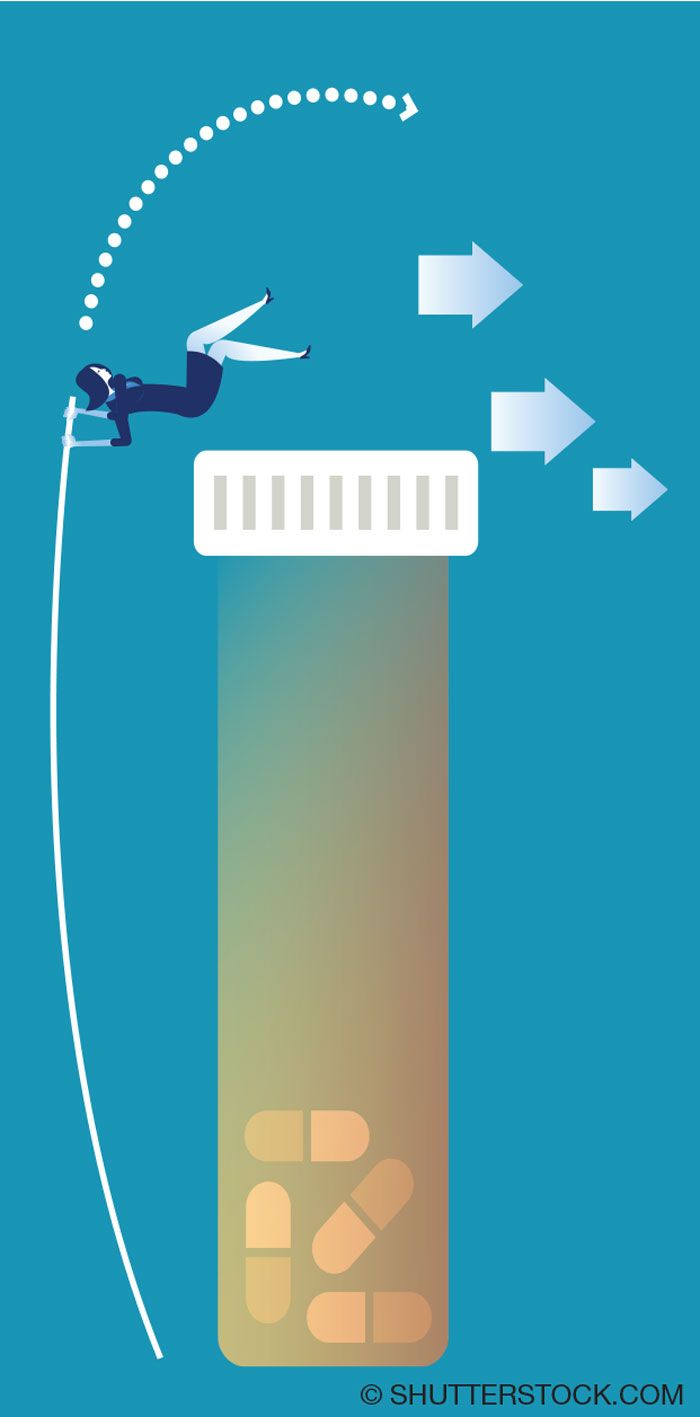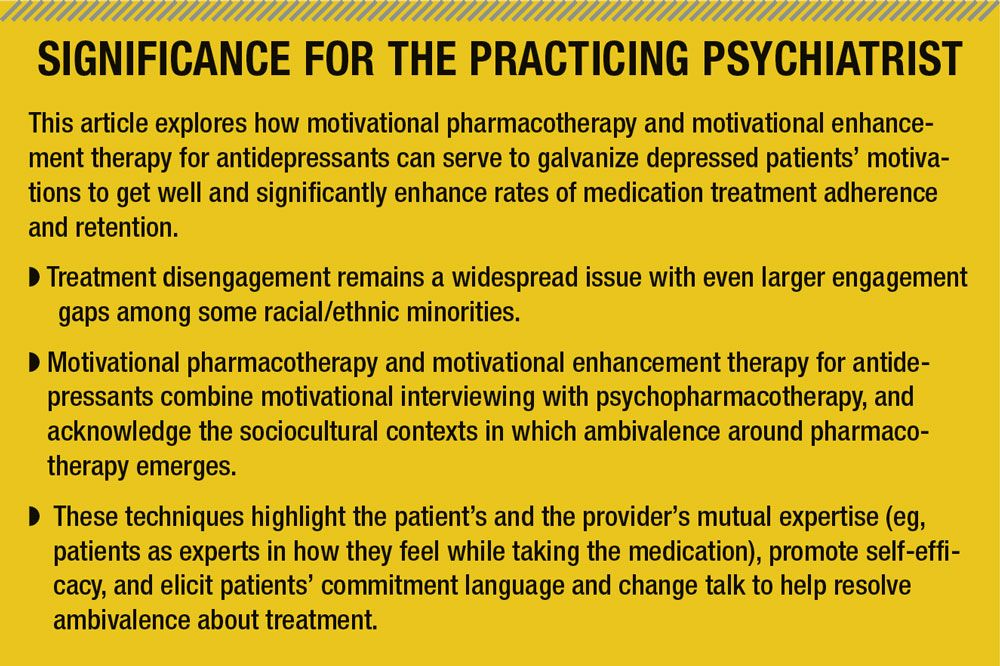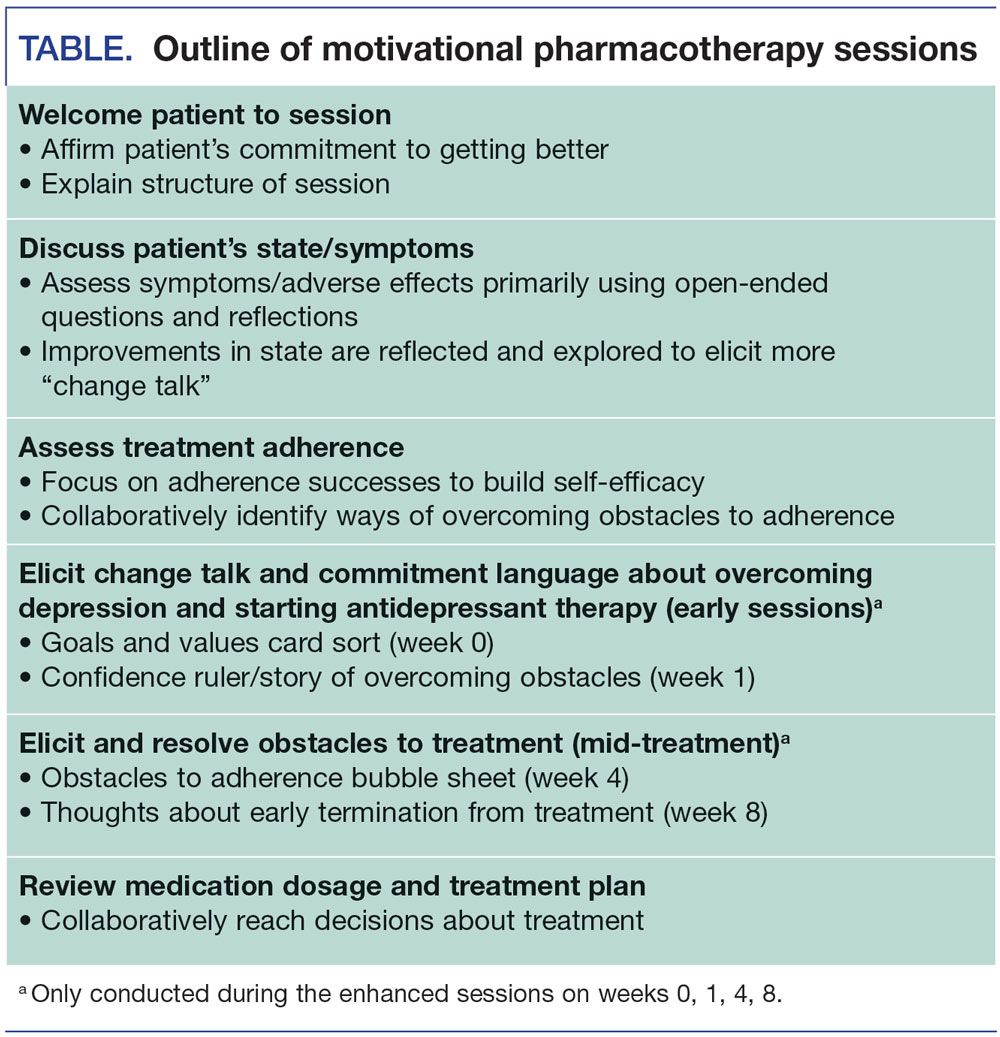Publication
Article
Psychiatric Times
Harnessing Patients’ Own Motivation to Engage in Pharmacotherapy
This article explores how motivational pharmacotherapy and motivational enhancement therapy can galvanize depressed patients to get well.
© shutterstock.com

SIGNIFICANCE FOR THE PRACTICING PSYCHIATRIST

TABLE. Outline of motivational pharmacotherapy sessions

A 39-year-old woman with MDD has been taking an antidepressant under your care for 3 weeks. Her dosage increases have been slow and steady, and she is starting to improve. But now she asks to discontinue her treatment. Her complaint? A mild tremor. “My nerves are becoming uncontrolled,” she says. You establish that the tremor does not interfere with functioning and provide psychoeducation that the tremor is mild and may decrease over time. She insists on stopping the medicine. What do you do?
Depression remains one of the leading causes of disability and early mortality in the US.1 Despite effective psychosocial and pharmacologic treatments for depression, their use remains low: fewer than 20% of Americans with moderate symptoms of depression saw a mental health professional in the past year.2 Even when treatment is received, it is often inadequate. Moreover, it is important to note that early treatment discontinuation increases the risk of recurrence.3
Antidepressants are a key therapeutic modality for depression, yet nonadherence remains a substantial barrier. In the US, 42.4% of adults with depression discontinue antidepressant therapy during the first 30 days and only 27.6% continue for over 90 days.4
Compared with non-Latino whites, racial/ethnic underserved groups have lower rates of antidepressant initiation and retention.5 Access and affordability are important reasons for this, but other key factors also contribute to lack of treatment. For example, Latinos and non-Latino blacks are less likely to receive guideline-concordant psychopharmacologic care than non-Latino whites, which may be the cause for lower confidence in treatment. Minorities are also less likely than non-Latino whites to find antidepressant medication acceptable.6
As with any patient, what is deemed acceptable to an individual is deeply influenced by that person’s specific social and cultural contexts. For example, cultural factors that influence some Latinos’ decisions about treatment with antidepressants include illness constructions that are inconsistent with antidepressant therapy and elevated concerns that medications are harmful or addictive.7 This may result in a marked ambivalence about taking medications for mental health problems.
On the one hand, many patients hope medications will help provide relief; on the other hand, they are afraid medications will harm them. An approach to pharmacotherapy that emphasizes an appreciation of patients’ sociocultural contexts is critical to addressing treatment adherence disparities and improving adherence among all patients.
Motivational interviewing
Motivational interviewing (MI) is an intervention that at its very core is patient-centered. It lends itself to working synergistically with approaches that take into account the sociocultural contexts in which ambivalence about pharmacotherapy emerges. MI focuses on eliciting and utilizing the patient’s own intrinsic motivation as opposed to imposing outside pressure to facilitate behavior change. It incorporates open-ended questions, reflections, and affirmations to help patients explore their ambivalence about a choice. The aim is ultimately to assist the patient in resolving the ambivalence, especially by avoiding interactions that impede internally motivated change such as directing the patient to change or prematurely raising concerns about a patient’s behaviors-which can lead to defensiveness. MI’s strong emphasis on patient empowerment, values, and motivations makes it particularly well-suited for the personalization needed to make treatment culturally compatible. In a meta-analysis of 72 clinical trials that examined MI for a range of problems, observed effect sizes of MI were larger among ethnic minority populations.8
MI can be very useful for addressing ambivalence about psychopharmacologic issues. Two approaches have been developed that show initial efficacy. The first is to integrate MI directly into the procedures followed by the prescriber. This approach is called motivational pharmacotherapy (MPT). The second approach is to add adjunctive MI sessions by a psychotherapist to the psychopharmacologic regimen. This approach is called motivational enhancement therapy for antidepressants (META). Both approaches are focused on galvanizing patients’ internal motivation to feel better while navigating their ambivalence about taking medication. Both elaborate an empathetic and non-confrontational process to sidestep initial resistance to treatment and work to highlight patients’ strengths and build self-efficacy. The clinician and the patient contribute their expertise in making treatment decisions-patients are the experts on their reactions to a medication, and clinicians are the experts on the medication itself (eg, adverse effects, dosage).
MPT and META were initially developed for use with low-income, largely Spanish-dominant Latino immigrants with MDD. The goal of both approaches is to attain cultural congruence with the values, attitudes, and illness representations common in some Latino populations, while being mindful to personalize care to the individual patient and not operate based on stereotypes. Although initially developed for a specific study population, MPT and META can be beneficial for many patient groups through simple tailoring procedures for a patient’s culture and disorder(s).
Motivational pharmacotherapy
MPT sessions follow a common structure (Table). Each session affirms a patient’s commitment to feel better and explores the current illness experience and medication adverse effects using open-ended questions. Improvements are reflected back to the patient and explored to elicit commitment language and change talk (ie, statements that reflect some resolution of ambivalence).
Adherence successes are highlighted in an attempt to build self-efficacy, and obstacles are identified. Exercises are added at strategic points to elicit a patient’s commitment to overcoming depression or to starting antidepressants. For example, in the first week, patients are asked about a success story from their life. They are asked to recall challenges they faced during that particular journey toward success and to explore the uncertainty they experienced but overcame. Throughout the exercise, the clinician reflects back any statements of self-confidence and determination (eg, so you were surprised at how effective your efforts proved to be).
Sessions are also used to elicit information about obstacles and how to resolve them, including exploring thoughts about early termination. In addition, sessions include review of medication dosage and collaborative decision-making about the treatment plan. Importantly, this is not done in a didactic way but by eliciting the patient’s opinions as to how to proceed.
A patient returns for his follow-up appointment. He had been prescribed an antidepressant for MDD to be taken for 9 months. He reports various adverse effects and informs his psychiatrist that he decided to discontinue the medication a week ago. He highlights his clinical improvement thus far and states that his body is now “rejecting” the medication. The following dialogue is an example from an MPT session.9
Clinician: So, what would your plan be, what would be the next step?
Patient: You are the doctor, so you decide. We had decided that I would take the medication for the next 9 months, but since I had to stop the medication-not because I wanted to but because my body was rejecting it-I would like to continue with treatment for the 9 months and see how my body is doing without the medication. I don’t know if you would be in agreement with that.
Clinician: So continuing to come, but evaluating the need for the medication; not necessarily taking it, but evaluating how you continue without it and seeing if there is a need for change.
Patient: If you want to, you can even give me the medication, though I wouldn’t take it. And if there is a problem, I would have it there.
Clinician: To take?
Patient: Yes, to take if anything happens. But more than anything I would like you to do an evaluation after 3 months to see what my reaction is to not taking the medication.
Clinician: What you propose is interesting. I think it’s fine. It’s a process during which we evaluate jointly what needs to be done. What you are proposing is that we can evaluate your situation without you necessarily taking the medication, something that your body is telling you that, at this specific time, it shouldn’t take. The advantage is that we can continue to evaluate you without you having to take the medication.
Patient: Because in reality, I would like you to continue treating me in this manner and see what happens.
Clinician: Yes, I think that is perfectly fine. The concern that I have-and it’s a concern that we can talk about and don’t have to reach a decision about today-is that there is a risk that the depression might return more quickly if you take the medication for less time. That is, you have been taking the medication for a few months, and that is good; you have that treatment in your body, no one can take that from you, and it might be sufficient to protect you.
Patient: If it were up to me . . . I would continue to take the medication longer. If it were possible, I would do so, but in reality-maybe it sounds illogical-but really it’s my body that is rejecting the medication.
Clinician: I understand, that is very clear. Because I like your plan, how about if we do the following? We are in agreement about you staying in treatment for 9 months, evaluating you and seeing you. During the visits, we would see how you are doing and based on that decide if it’s worth trying to start the medication again or not. As we continue, we’ll decide on a month-to-month basis. I can even give you some medication in case you decide you want to take some. As you said, having it just in case is a good idea.
Patient: Yes, I brought back the pills I didn’t take, and I can take those back with me. I don’t like to take a medication unless I have to, and right now, I don’t need it. I feel strong, so I don’t think I need the medication now, but as you say, maybe in the future I might relapse. I really want to continue treatment with you.
Clinician: I agree, the main point is to continue treatment.
One month later, the patient reports that he restarted the antidepressant 2 weeks earlier when he noted worsening of depression symptoms. He continued to take the antidepressant as originally planned and completed the 9 months of pharmacotherapy.
The initial open trial of MPT focused on retention at 3 months, which revealed low levels of discontinuation compared with historical controls at the same clinic (20% vs 45%) among a traditionally underserved and resource-limited population.10 Responder and remitter rates were 82% and 68%, respectively. Notably, the average duration of the sessions was 36.7 minutes for the initial visit and 24.3 minutes for follow-up visits. This illustrates that MPT sessions do not have to be longer than a typical pharmacotherapy session. Results from a larger, randomized controlled trial are currently being analyzed.
Motivational enhancement therapy for antidepressants
META is a 3-session MI-based intervention that a psychotherapist administers adjunctively to pharmacotherapy sessions. It differs from MPT chiefly in that there is no direct integration with pharmacotherapy sessions, which take place with another clinician, and in its time-limited 3-session framework.
A randomized controlled trial that focused on adherence revealed that META participants had significantly higher antidepressant adherence than usual-care recipients at 5 weeks (72% vs 42%) and at 5 months (60% vs 34%).11 In adjusted analyses, META participants were significantly more likely to show symptom remission.
Conclusion
Armed with information on MPT and META, how would you handle the dilemma presented by the patient at the beginning of the article? She is an immigrant from the Dominican Republic who was seen in the MPT trial and responded very well to MI techniques that explored her concerns about medication adverse effects. She revealed her fear that the tremor indicated the onset of a progressive nervous system condition that would result in total loss of motor control if she continued the antidepressant-her nerves would be irrevocably altered. This would lead to permanent disability and the destruction of her family, who depended on her.
Eliciting her ideas about possible treatment options resulted in her choosing to try a different antidepressant. This second medication did not produce a tremor, and she was able to complete the trial and achieve symptom remission.
Poor treatment adherence remains a substantial challenge. Novel strategies continue to emerge, including those adapted from MI. We encourage clinicians to incorporate them in their practice and to continue to improve on them. It is essential that all novel interventions address not only those communities with easier access to care, but also those who are traditionally underserved, among whom non-engagement is substantially worse. This can be facilitated by developing treatment modalities that incorporate the patient’s own views of illness and care.
Acknowledgment-The Table and the dialogue on page 14 are adapted from Balán et al9 with permission from Taylor and Francis Group LLC.
Disclosures:
Dr. Lewis-Fernández is Professor of Clinical Psychiatry and Director of the New York State Center of Excellence for Cultural Competence, and Dr. Coombs is a Resident Physician in the Department of Psychiatry, Columbia University, and New York State Psychiatric Institute, New York, NY.
The authors report no conflicts of interest concerning the subject matter of this article.
References:
1. Kessler RC. The costs of depression. Psychiatr Clin North Am. 2012;35:1-14.
2. Pratt LA, Brody DJ. Depression in the US household population, 2009-2012. NCHS data brief, No. 172. Hyattsville, MD: National Center for Health Statistics; 2014.
3. Yau WY, Chan MC, Wing YK, et al. Noncontinuous use of antidepressant in adults with major depressive disorders: a retrospective cohort study. Brain Behav. 2014;4:390-397.
4. Olfson M, Marcus SC, Tedeschi M, et al. Continuity of antidepressant treatment for adults with depression in the United States. Am J Psychiatry. 2006;163: 101-108.
5. González HM, Vega WA, Williams DR, et al. Depression care in the United States: too little for too few. Arch Gen Psychiatry. 2010;67:37-46.
6. Cooper LA, Gonzales JJ, Gallo JJ, et al. The acceptability of treatment for depression among African-American, Hispanic, and white primary care patients. Med Care. 2003;41:479-489.
7. Cabassa LJ, Lester R, Zayas LH. “It’s like being in a labyrinth”: Hispanic immigrants’ perceptions of depression and attitudes toward treatments. J Immigr Health. 2007;9:1-16.
8. Hettema J, Steele J, Miller WR. Motivational interviewing. Ann Rev Clin Psychol. 2005;1:91-111.
9. Balán IC, Moyers TB, Lewis-Fernández R. Motivational pharmacotherapy: combining motivational interviewing and antidepressant therapy to improve treatment adherence. Psychiatry. 2013;76:203-209.
10. Lewis-Fernández R, Balán IC, Patel SR, et al. Impact of motivational pharmacotherapy on treatment retention among depressed Latinos. Psychiatry. 2013;76:210-222.
11. Interian A, Lewis-Fernández R, Gara MA, et al. A randomized-controlled trial of an intervention to improve antidepressant adherence among Latinos with depression. Depress Anxiety. 2013;30:688-696.






